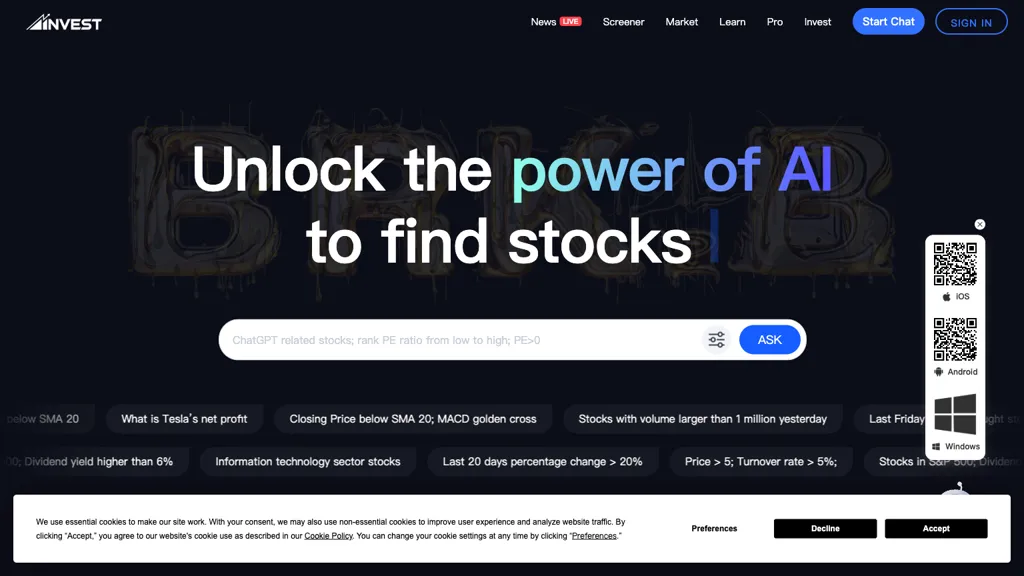20 Best Advice To Deciding On AI Stock Predictions Platform Sites
20 Best Advice To Deciding On AI Stock Predictions Platform Sites
Blog Article
Top 10 Tips To Assess The Integration Of Ai Platforms For Stock Prediction And Analysis And Their Compatibility
Integrity and compatibility are two of the primary factors to consider when evaluating AI software for stock forecasting and analyzing trading platforms. Integrating your platform into existing tools, systems and workflows is excellent way to improve efficiency. Here are 10 suggestions to help you assess the compatibility and integration of these platforms.
1. Check Brokerage Integration
Supported brokers - Make sure that the platform you choose to use is connected to your brokerage account or trading account.
Trade execution: Check whether your platform allows you to execute trades directly via the integrated broker.
Account Synchronization: Ensure whether your platform is able to sync real-time balances of your account as well as positions and transaction history.
2. Evaluate API Availability
API access - Ensure that the platform includes an API to allow developers to create custom tools or automate work flow.
API documentation: Make sure that the API is well-documented with clear examples and use cases.
Rate limits: Verify if the API has acceptable rate limits and is able to handle your anticipated amount of usage.
3. Integration of Third-Party Tools
Popular Tools: Make sure the platform has integrations with other tools, such as Google Sheets and Excel.
Export and import of data. Ensure your platform can import and export data easily from other tools.
Extensions and plugins: Make sure the platform is able to support plugins or extensions. These add functionality.
4. Test Compatibility With Operating Systems
Desktop compatibility: Make sure that the application works with the operating system you prefer (Windows, macOS, Linux).
Mobile compatibility. Check if you can download the app on iOS or Android.
Web-based access: Determine if the platform can be accessible via a web browser for more flexibility.
5. Assessing the Data Integrity Capabilities
Data sources - Check that the platform is linked to different sources of data (e.g. news feeds, market data, sentiments on social media).
Real-time data streams: Confirm that the platform has the ability to incorporate live data streams to provide the most up-to-date analysis.
Check to see if your platform supports the import of historical data for backtesting or analysis.
6. Cloud and On Premise Compatibility
Cloud-based platforms: Make sure that the platform is available from any location connected to the internet.
Solutions on-premise: If prefer to deploy on premises, check that the platform you are using supports it.
Hybrid models: Determine if the platform combines cloud-based and on-premise capabilities.
7. Check for Cross Platform Syncronization
Device synchronization. The platform should connect settings and data to all devices including mobile, desktop and tablet.
Check if changes made to the device immediately reflect on another.
Offline Access: Make sure to see if there are any limitations on the platform's functionality or data access if it is offline.
8. Verify compatibility between trading strategies
Automated or algorithmic trading: Verify that the platform for trading is compatible with these strategies.
Custom indicators. Find out if the platform allows you to utilize scripts or technical indicators.
Strategy backtesting - Check to see if your trading platform permits backtesting using historical data.
9. Examine Security and Compliance
Data encryption: Make sure that the platform uses encryption of data in the both in transit and at rest.
Validation: Determine whether the platform supports secure authentication methods (e.g., two-factor authentication).
Regulatory compliance: Check if the platform is compliant with applicable regulations (e.g., GDPR, FINRA, SEC).
10. Test Scalability & Performance
Scalability - Make sure that the platform you choose will meet your ever-growing needs in terms of users and data.
Performance under load: See whether the platform performs well in high-volatility markets.
Resource usage - Check that the platform effectively uses system resources like CPU, memory or bandwidth.
Bonus Tips
User feedback: Review user testimonials and reviews to assess the platform's ability to integrate.
Trial period: Take advantage of an unpaid trial or demo to experience the system's integration with your existing workflow and tools.
Customer Support: The platform needs to offer robust support when it comes to integration issues.
These guidelines will help you evaluate the compatibility and integration capabilities of AI software for analyzing and predicting stocks. This will help ensure that they are compatible with your existing systems and increase your efficiency in trading. See the top ai trading advice for more info including incite, ai stock picker, stock ai, ai stocks, ai for investing, ai trading tools, best ai stock trading bot free, best ai stock, ai for stock trading, ai trading and more.
Top 10 Tips On Assessing The Transparency Of Ai Stock Predicting/Analyzing Trading Platforms
Transparency plays a crucial role in assessing AI-driven trading and stock prediction platforms. It guarantees that the users can trust the operations of the platform, understand how decisions are made, and verify the accuracy of predictions. These are the top ten tips to evaluate the credibility of these platforms:
1. AI Models explained in clear terms
Tip: Check if the platform gives a clear explanation of the AI models and algorithms used to make predictions.
What is the reason? Understanding the fundamental technologies helps users evaluate its credibility.
2. Disclosure of Data Sources
Tips: Find out whether the platform makes public what sources of data are being used (e.g. historic stock data, news or social media).
What's the reason? Knowing where data comes from will ensure that the platform has complete and accurate data.
3. Performance Metrics Results and Backtesting
TIP: Always look for transparent reporting on performance metrics such as accuracy rates and ROI, as well as testing results back to back.
What is the reason? It allows users to verify their past performance as well as the efficacy of their platform.
4. Updates and notifications in real-time
Tip - Check to see whether there are any real-time notifications, updates, and trades on the platform.
Why: Real time transparency keeps users informed about every critical action.
5. Limitations - Open communication
TIP: Check if your platform provides information about the limitations and risks of the trading strategies it uses and its predictions.
Why: Acknowledging limitations builds confidence and allows users to make educated choices.
6. Raw Data Access for Users
Tip: Determine if the AI model is able to access raw data, intermediate results or both.
The reason: The raw data is accessible to the user for their personal analysis.
7. Transparency and honesty in costs and fees
Tips: Ensure that all subscription fees, charges, and cost-savings are clearly stated on the platform.
Transparent Pricing: It creates trust by preventing unexpected costs.
8. Regularly scheduled reporting and audits
TIP: Find out if the platform is regularly updated with reports or undergoes audits from third parties to confirm the operation and efficiency of the platform.
The benefits of independent verification are that it increases credibility and accountability
9. Explainability and Predictions
Tips: Find out about how the platform generates predictions or specific suggestions (e.g. features importance or decision trees).
The reason: Explainability helps users to be able to comprehend AI decisions.
10. User feedback and support channels
Tip: Determine whether there are clear channels for users to share their feedback and also receive assistance. Also, determine whether the company is transparent in the way it responds to issues expressed by users.
Why is that responsive communication demonstrates a commitment for the transparency of users and their satisfaction.
Bonus Tip Regulatory Compliance
Check that the platform conforms to relevant financial regulations, and make sure it discloses this compliance status. This will provide an additional level of transparency.
When you thoroughly examine these elements you will be able to judge whether an AI trading and stock prediction platform operates transparently, enabling you to make educated decisions and build confidence in the capabilities of AI. Read the top rated free ai tool for stock market india recommendations for website examples including best ai stocks to buy now, ai tools for trading, stock predictor, stock trading ai, investing with ai, ai share trading, best stock prediction website, stock predictor, can ai predict stock market, ai trading tool and more.